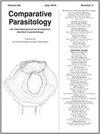Prevalence of Endoparasites in the Balkan Donkey (Equus asinus) from Serbia
IF 0.4
4区 医学
Q4 PARASITOLOGY
引用次数: 0
Abstract
ABSTRACT: The Balkan donkey, Equus asinus, is an endangered indigenous breed that was once found in the wider area of the Balkan Peninsula, especially in the hilly and mountainous areas of Serbia. It is estimated that today there are about 1,000 of them left, mostly in animal genetic resources breeding centers. They are characterized by exceptional resistance to disease and, to date, have not been subject to disease prevention measures, including parasite control. Herein, we examined parasite species richness and prevalence of endoparasites in 60 adult donkeys of both sexes from 3 sites: Stara planina Nature Park (a mountainous region corresponding to the original habitat where this species was once bred); Zasavica Special Nature Reserve (a plain area at the mouth of the Zasavica in the Sava River), and Krčedinska ada (a marsh island on the Danube River near Novi Sad). We found the most prevalent parasites were Dictyocaulus arnfieldi (68% at Stara planina and 100% at the other 2 sites); Trichostrongylus axei (38% at Stara planina, 57% at Zasavica, and 86% at Krčedinska ada); Strongylus vulgaris (32% at Stara planina and 435% at Krčedinska ada); and Strongylus edentatus (57% at Zasavica and 14% at Krčedinska ada). In addition, we found Cyathostomum spp., Anoplocephala spp., Eimeria leuckarti, and Eimeria solipedum in smaller numbers.塞尔维亚巴尔干驴(Equus asinus)体内寄生虫的流行
摘要:巴尔干驴(Equus asinus)是一种濒临灭绝的本土品种,曾在巴尔干半岛广大地区,尤其是塞尔维亚的丘陵山区被发现。据估计,目前约有1000只,大部分在动物遗传资源育种中心。它们的特点是对疾病具有非凡的抵抗力,迄今为止,还没有采取包括寄生虫控制在内的疾病预防措施。在此,我们检测了来自3个地点的60头成年驴的寄生虫物种丰富度和内寄生虫的流行率:Stara planina自然公园(一个山区,对应于该物种曾经繁殖的原始栖息地);扎萨维卡特殊自然保护区(萨瓦河扎萨维卡河口的一个平原地区)和Krčedinska ada(诺维萨德附近多瑙河上的一个沼泽岛)。我们发现最常见的寄生虫是阿氏Dictyocoulus arnfieldi(在Stara planina为68%,在其他2个地点为100%);axei毛圆线虫(Stara planina占38%,Zasavica占57%,Krčedinska ada占86%);普通圆线虫(Stara planina占32%,Krčedinska ada占435%);和齿圆线虫(Zasavica占57%,Krčedinska-ada占14%)。此外,我们还发现了数量较少的Cyathostomum spp.、Anoplocephala spp.、leuckarti艾美耳球虫和单脚艾美耳球虫。
本文章由计算机程序翻译,如有差异,请以英文原文为准。
求助全文
约1分钟内获得全文
求助全文
来源期刊

Comparative Parasitology
医学-动物学
CiteScore
1.00
自引率
0.00%
发文量
16
审稿时长
>12 weeks
期刊介绍:
Comparative Parasitology (continuing the Journal of the Helminthological Society of Washington in its 67th volume) focuses on parasitological research of a comparative nature, emphasizing taxonomy, systematics, ecology, biogeography, evolution, faunal survey, and biological inventory within a morphological and/or molecular context. The scope of Comparative Parasitology extends to all parasitic faunas, including helminths, protistans and arthropods.
 求助内容:
求助内容: 应助结果提醒方式:
应助结果提醒方式:


